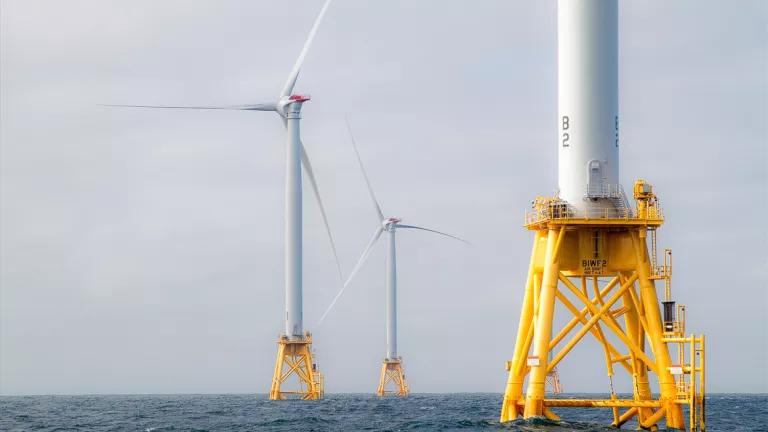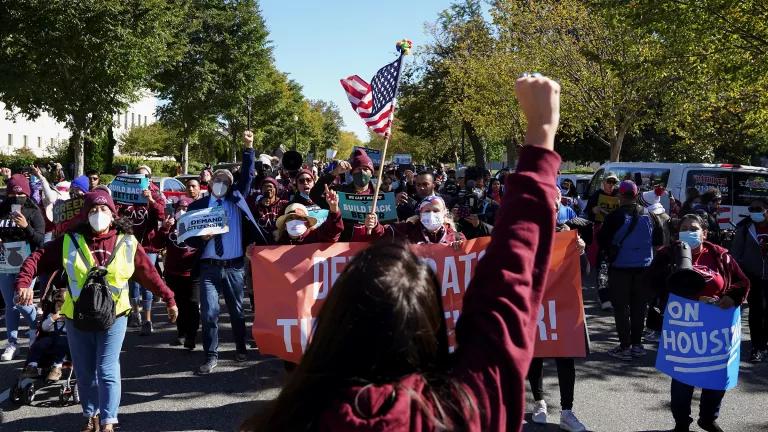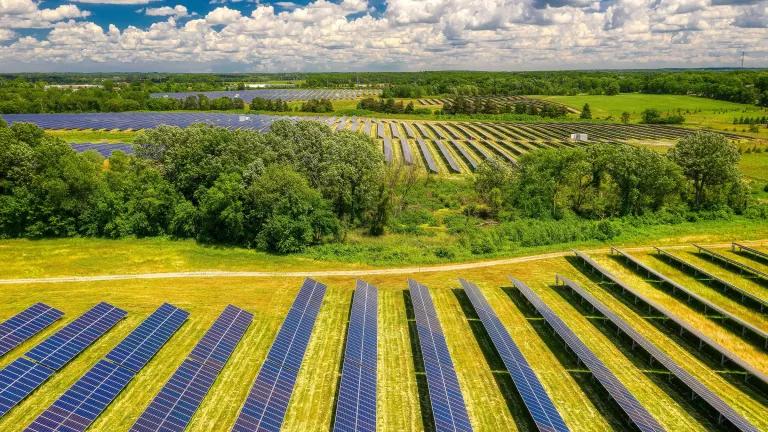Top Climate Elements in Senate Budget Reconciliation
The Inflation Reduction Act of 2022 will reduce greenhouse gas and other pollutants by giving people clean energy choices at low cost reduce household and business energy bills.
The Inflation Reduction Act of 2022, which was rolled out this week includes a broad range of investments across most sectors of the economy. It will reduce greenhouse gas and other pollutants by giving people clean energy choices at low cost reduce household and business energy bills. This could not be more timely given how much high fossil fuel costs are driving up what people are paying at the pump and on utility bills. We urge Congress to pass this bill.
We are still digesting the bills details, but our initial analysis indicates that, if properly implemented, the bill could deliver an emission cut of 40% or more by 2030. Future action, like new rules, standards and policies at the federal and state levels, could build on this success and help us reach the 50-52 percent reduction by 2030 target set by the Biden administration.
While the bill is not what we would have written and does include bad elements, such as provisions tying renewable leasing with fossil leasing on federal lands, our preliminary estimate is that positive climate provisions could outweigh the negative by eight to ten times from a greenhouse gas emissions perspective. This bill includes several major provisions that could help cut climate-warming pollution and these are some of the investments that deliver the GHG reductions. Reducing the use and combustion of fossil fuels will both reduce GHG emissions and other air pollutants.
1. Clean Electricity Tax Credits
- Who they help: These programs help people and businesses install new clean electricity, like wind and solar, by providing tax credits to buy-down the cost of the projects. There are requirements and bonus credits to encourage the projects pay well and provide good jobs, encourage domestic manufacturing, and incentivize clean energy investment in low-income and former fossil communities.
- What they deliver: These credits will usher in the fastest – and most sustained – build-out of renewables and other low- and no-carbon energy resources in the country’s history. Our analysis indicates that solar and wind capacity in the U.S. could grow by over 150% this decade, with the credits supporting up to 190,000 new jobs in the renewable energy industry (like wind technician or solar installer) by 2030. New renewable projects can also lower power prices for all consumers by reducing our exposure to spiking and volatile fossil fuel prices, like we are seeing today. Our analysis suggests the average residential electric bills could be 8% lower by 2030 with, versus without, clean energy tax credits.
- Climate benefits: Our analysis indicates GHG emissions in the power sector could be reduced by up to 320 million metric tons (MMT CO2-eq) annually by 2030 (equal to the annual emissions from all the power plants in Texas, Pennsylvania, and Ohio in 2021).
- Other benefits: Building out a cleaner electricity system can also lead to large reductions in air pollutants that contribute to local soot, smog, and ozone. Reductions in nitrogen oxides (NOx) and sulfur dioxide (SO2) emissions from power plants due to these tax credits could result in up to $9.2 billion in annual public health benefits by 2030.
2. Funding Programs to Support Local Clean Investment
- Who they help: The bill includes a number of programs designed to direct money to communities and non-profit lending institutions to support local deployment of clean energy, vehicles, and other climate-friendly solutions. This includes a $27 billion Greenhouse Gas Reduction Fund that will support non-profit lending institutions in delivering low-cost financing for clean energy projects, leveraging private sector investment to deploy a wide range of clean energy, transportation, buildings and industrial technologies that reduce will climate pollution. $7 billion in this fund is designated to install zero-emissions distributed technologies in low-income and disadvantaged communities. There are also $3 billion for Environmental and Climate Justice Block Grants that can be invested in community-led projects to address local environmental and public health harms in frontline and disadvantaged communities. This program can also support and help build community capacity to address the disproportionate impacts these communities bear from pollution and climate change.
- What they deliver: Public and private funding will support new investment in things like roof-top solar power in low-income communities, clean transportation and transit options like electric buses, and smart grid investments that can increase the resiliency and reliability of our local power systems. These programs can complement other elements of the bill, like clean energy tax credits, to help these credits and clean energy investments reach smaller projects and disadvantaged communities that would otherwise be unable to access or enjoy the benefits of these credits.
- Climate benefits: These programs could help reduce up to 120 MMT of CO2 annually by 2030, or equal to the carbon pollution from the annual home energy needs of 15 million U.S. households.
- Other benefits: These programs will help spur significant new, private investment in clean energy projects across the U.S. For example, every $1 invested in the GHG Reduction Fund could leverage between $5 and $9 in total public and private sector investment, depending on the project use. The Environmental and Climate Justice Block Grants would empower low-income communities, communities of color, indigenous communities with resources that can be used to leverage other public and private sector investments in sustainable economic development.
3. Clean Vehicle Incentives
- Who they help: The bill includes tax credits that will help people buy new and used plug-in or fuel cell electric vehicles by providing tax credits to buy-down the cost of the purchase. Low- and middle-income U.S. households will be able to get $7,500 when purchasing a new vehicle and $4,000 when purchasing a used vehicle. There are also grants and funding that will support the purchase of clean trucks and commercial vehicles and invest in local neighborhood affordable transit options.
- What they deliver: Clean vehicle tax credits will allow more Americans to buy electric vehicles, increasing communities’ access to clean vehicle options, and direct grants and funds for communities, agencies, and ports to purchase clean vehicles will mean fewer polluting commercial vehicles on the streets and in communities. These incentives and other clean vehicle programs—including tailpipe pollution standards—could help accelerate the transition to clean vehicles in the United States. Half of new passenger vehicle sales could be electric by the end of this decade, up from around 5% of sales today.
- Climate benefits: These provisions could help cut up to 101 MMT of CO2 annually by 2030 (equal to the annual pollution from 21.5 million cars).
- Other benefits: Electric vehicles, and these credits that will help more consumers afford them, can help shield Americans from rising energy prices and reduce our dependence on foreign oil. In addition, by getting gas- and diesel-powered cars and trucks off the roads, we can reduce harmful tailpipe pollution that contributes to unhealthy air in our communities that can lead to respiratory illnesses, lost work and school days due to illness, ER visits, and premature death.
4. Agriculture & Conservation
- Who they help: The bill includes over $25 billion in funding to be used to support conservation efforts on agricultural and forested lands and ecologically sensitive habitats. Funding will also go to farmers that implement new agricultural management and on-farm conservation practices. In addition, the bill includes $1.5 billion for urban tree planting.
- What they deliver: This funding will benefit both rural and urban communities. Investments in and restoration of our national forests and parks will protect the unique habitats and recreational areas across the U.S. for people and animals. Agricultural programs can provide rural communities with the funding to undertake investments that will improve soil health and reduce nitrogen losses, while urban tree planting can cool hot city streets, provide shade, clean local air, and filter stormwater. These investments support programmatic funding in areas where existing resources are in short supply, and long waiting lines for conservation programs limit the capacity to transform this sector.
- Climate benefits: This funding could result in up to 76 MMT of additional carbon sequestered in our natural and working lands by 2030, or the amount of carbon currently sequestered by 90 million acres of U.S. forests.
- Other benefits: Investments in regenerative and organic conservation practices that prioritize soil health will have important ecological and environmental impacts, including preventing soil erosion—which costs in productivity losses each year. Investments in soil health also improve downstream water quality, which can help reduce the magnitude of harmful algal blooms while also improving nutrient cycling, which can help stem the use of chemicals and synthetic inputs. Synthetic inputs lost to agricultural runoff costs the United States about $157 billion per year in damages to human and environmental health.
5. Funding, Investments, and Incentives for Heavy Industry and Manufacturing
- Who they help: The bill includes programs that will provide direct grants to help American manufacturers in the most energy-intensive industrial sectors like cement, steel, and aluminum install and implement transformational technologies to deeply decarbonize their plants, as well as tax credits and incentives for advanced manufacturing and low-carbon technology adoption. These provisions can spur investments in clean electrified processes, energy efficiency, adoption of green hydrogen for clean steel manufacturing, installation of carbon capture and storage technology at cement plants, or other advanced technologies. The bill also includes funding for low carbon materials disclosure and labeling and roughly $5.5 billion for federal agencies to procure low-carbon industrial materials in federal infrastructure projects, boosting early markets for deeply decarbonized concrete, steel, and other widely used industrial products.
- What they deliver: These programs will provide manufacturers with the funds and incentives to retool their facilities, making U.S. industry cleaner, more efficient, and more competitive in the global market. These investments can also lower energy costs for industry. Similar Department of Energy industrial assistance programs have been able to save U.S. industry billions of dollars, helping keep U.S. manufacturing competitive in the changing global economy. The procurement of these low-carbon materials by the government can also help shift the broader market for these materials to cleaner options.
- Climate benefits: These programs could cut up to 150 MMT of CO2 annually by 2030.
- Other benefits: Investments in low-carbon industrial processes and upgrades have the potential to reduce many types of industrial pollution, improving the health and air quality of nearby communities. Additionally, a recent report from the IEA, Net Zero by 2050, estimates that global demand for clean energy and sustainable infrastructure materials will reach $5 trillion per year by 2030. Because industrial decarbonization is being driven by technologies that exist today, making this major investment now to help our factories cut emissions will help them produce the low carbon industrial products the U.S. and the world will increasingly rely on. Doing so will not only help tackle the climate crisis but support good jobs and strengthen our manufacturing base.
These climate elements are only a portion of a comprehensive package. Other elements invest in: environmental justice, tribal and low-income communities; building energy efficiency; climate adaptation; EPA and state pollution reduction programs; NEPA implementation across agencies; and many other programs.
We urge Congress to pass this bill.




